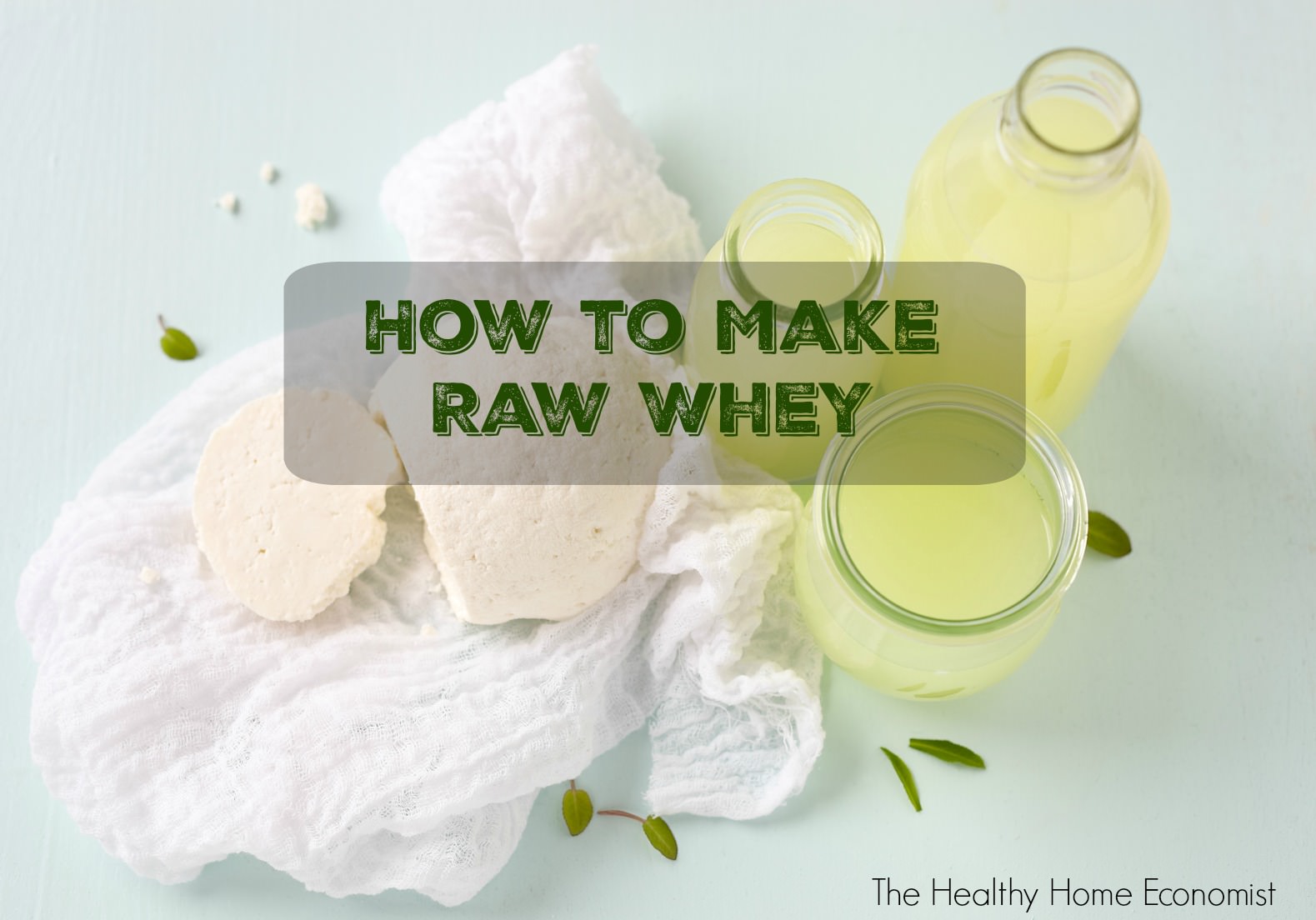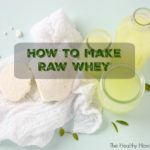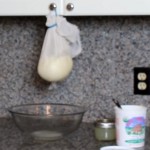How to make raw, enzyme and probiotic-rich liquid whey to use as a starter culture for all your home fermentation needs.

Do you know how to make whey from yogurt, kefir or raw milk?
A by-product of this simple technique is healthy homemade cream cheese that is loaded with enzymes and probiotics.
The recipe below describes how with visual instructions via video demonstration!
Making homemade baby formula? I recommend using this “quick whey” no straining method as the fastest and easiest approach.
How to Make Whey the REAL Way
Making real, liquid, nutrient rich, unadulterated whey in your own kitchen is a MUST step for any traditional cook to learn.
Without whey in its whole, liquid form, many other traditional recipes cannot even be attempted. You cannot buy whey from the store except in a denatured, unhealthy, powdered whey form. It is worth your time to learn what I show you in the video below.
Other video lessons on this blog show you how to use this whole food form of whey to make many delicious, healthful recipes for your family. Whey as made in the video demo below will keep up to 6 months in the refrigerator in a sealed mason jar.
If you absolutely have no access to farm fresh milk to make whole, unadulterated, enzyme rich whey, then you can use plain, organic yogurt brand from the store instead. Here are tips on how to spot the best yogurt brands.
The process is basically exactly the same thing as shown in the video.
You won’t get nearly as much whey using yogurt as clabbered, farm fresh milk, but at least you can get enough to get you started.
Wonderful Whey and REAL Cream Cheese
The raw, enzyme-rich cream cheese I make in the recipe video below is fantastic on a sprouted or sourdough bagel for breakfast. Don’t buy the Ezekiel sprouted muffins as they contain soy. This low-carb bagel recipe is another great one to try.
If you prefer to buy, these sourdough bagels are available for shipping freshly made to your door.
To make, just take your cream cheese left over from making liquid whey and add a few strawberries and a dash of dark maple syrup to taste. Mix together by pulsing a few times in your food processor. This wonderful, fresh, REAL strawberry cream cheese will last one to two weeks in the refrigerator. Another wonderful use for this healthy raw cheese is to make an easy no bake cheesecake.
No access to raw milk where you live? No problem. Check out this recipe plus video on how to separate whey from yogurt purchased from the store.
Cloudy Whey vs Clear Whey
No matter whether your whey turns out cloudy or clear, it is safe and fine to use in all your favorite recipes. This article explains why sometimes whey is cloudy compared to its usual golden color.

Raw Whey Recipe
How to separate raw, liquid whey from clabbered milk. The process also creates probiotic rich cream cheese.
Ingredients
- 1 quart raw milk preferably grassfed
- 1 large glass bowl
- 1 large rubber band
- 1 white dishtowel
Instructions
-
Allow the raw milk to sit on the counter for 1-3 days at room temperature.
-
When the milk separates into curds and whey (transforms into clabbered milk) you are ready to proceed. Note that the fresher the raw milk and the colder the temperature of your house, the longer it will take the raw milk to clabber.
-
Line a clean, large glass bowl with a clean, white dishtowel that isn’t too thick. Cheesecloth will also work, but the holes in the mesh must be very small, else the milk curds will pass through.
-
Gently pour the clabbered milk into the middle of the dish towel. Gather up the ends and fasten with a rubber band. Attach to a knob on an upper cabinet in your kitchen as shown in the picture.

-
Let the raw whey drip into the bowl underneath. This process will continue for an hour or two.
-
After the dripping stops, gently take down the hanging bag and place it into a clean bowl. Scrape out the raw cream cheese that is inside the bag, put in a container with a lid and refrigerate.
-
Pour the liquid whey from the dripping bowl into a glass mason jar, afix the lid and refrigerate.
-
Refrigerated, raw cream cheese will be good to eat for about a week. Raw whey will last several months refrigerated.
Recipe Video
How to Use Whey in Recipes
How to Make Ricotta Three Ways (plus Video How-to)
Perfect Probiotic Cottage Cheese
Cheese Making: Common Problems and Solutions








Well, I answered my own questions! I put the “milky” whey back on the counter for probably a good week before I could finally see big chunks of milk floating with clear liquid mixed in. Sometimes, it just takes longer! I separated it using a regular old dish towel, and it separated perfectly into the cream cheese and the normal yellowish-clear whey. I do think a tea towel would be better though, because I lose a lot of whey separating it through the dish towel.
HI JL, sorry I missed your question the first time around! Glad it all worked out for you! Yes, tea towels work great for separating the whey.
I think I might be doing something wrong. The first time I ever made whey, it came out as is shown in your video (yellowish). However, I just tried to make some a week ago, and it came out milky. It did not clear up after being left in the fridge, so I decided to leave it out on the counter a few more days, and the milk clabbered slightly again. After pouring it through my towel again, it is still milky.
Am I not leaving it out long enough? Am I using the wrong kind of towel? The first time I made whey, I used a regular old kitchen towel. I used a regular kitchen towel this time too, but the whey was not clear. Does using a tea towel make a difference? I know it comes out different each time, but the fact that I could still clabber my “whey” after straining it once is not quite right, right?
Yes, it’s true that selling raw milk is illegal in some states (and in some, it’s not!). Some states sell cow “shares” instead. This means you buy a cow share and pay a monthly boarding fee and get raw milk on a consistent basis (i.e. weekly). Go to http://www.realmilk.com to find out where to obtain it in your state.
Sarah,
Thank you so much for this video! How long can the cream cheese be stored for? And I’m assuming I should store it in the fridge?
Thank you,
Katie
Ok, I am very new at this, so bear with me. I’ve used organic products, well never… I’m not even sure how to get half of this stuff. I’m finally crossing over, and making organic formula for my baby. I am going to make this Whey from the organic yogurt, so do I need to let it sit on the counter, as well, or is it already ready as yogurt has already been processed differently than milk? The steps are step for step the same? Sorry if this question is redundant, but I want to make sure I’m successful at making this the first time.
Hi Lauren, the yogurt is already cultured so you can strain out the whey immediately – do not sit it on the counter. You will just end up with liquid whey and yogurt cheese instead of liquid whey and cream cheese.
Whey is supposed to be sour. It is fine. No worries. You can certainly use the whey from a piima culture but that would taste sour as well.
I live in Georgia and it’s illegal here to sell raw milk. So I’ve never been able to find a farmer who will sell it to me. We do get our milk from a trusted local dairy farm that raises pastured, grass-fed holsteins and jerseys. It’s whole milk and non-homogenized, but it is low-temp pasteurized. I talked to the dairy farmer about it and he says that they use the lowest temp possible to keep it legal here in Georgia. But I can’t get raw milk from them. Do you have any suggestions? You said in your video that you can’t make the whey with low-temp pasteurized milk. So what should I do? I’m really new to all of this, but I just ordered the Nourishing Traditions cookbook and enjoy your blog so much. Excited to try some changes in how my family eats, even if I’m totally overwhelmed and not really sure where to start. Thanks!
Jennifer,
I live in Georgia and there is a dairy that delivers to locations in Metro Atlanta weekly. They sell raw milk that is labeled “not for human consumption..for pet use only”. The dairy is Carlton Farms http://www.carltonfarmsnaturalfoods.com/milk.shtml. Their cows are Jersey cows. Check out their website.
Any thoughts on how to clean the cheese cloth after making the whey and cream cheese? How do I make sure that I get all the particles out and what kind of cleaning agent do I use? I don’t want to use anything toxic like bleach. Thanks.
Watching your video brought a couple of questions to mind. I know that in many cases, too much heat can be a bad thing. But there are a couple of recipes I use that I love and now I’m wondering exactly what their nutritional benefits are. First if I want a cream cheese type spread, I often make a quick batch of cheese. It uses fresh milk heated to 185F. Then you stir in 1/4 cup of apple cidar vinegar per gallon of milk. It precipitates the solids immediately and you can drain it through a loose cloth in a short time to make a soft cheese. We can have cheese from the goat to the table in about a half hour that way. The color of the whey changes depending on how much acid you’ve added. The more cheese you get, the more clear yellow the whey. I suppose it just has less milk left in it. I use this whey in breads. Do you think the nutritional benefits of whey have been destroyed by the heat of making the cheese?
Also, when I make goats milk yogurt, I bring the milk to nearly a boil and then cool it before adding the yogurt culture. It makes a much thicker, creamier yogurt. I assumed that adding and growing the culture is where most of the probiotics, etc, come from, but am I loosing other good stuff by heating the milk?
Technically, I’d call that farmer cheese or the first step of cottage cheese, but a soft cheese like that can be wonderful in a lot of recipes. We mix it with garlic and dill for a wonderful veggie dip. If you wanted to make it thicker, you could use a more loosely woven muslin which would just drain more whey. The resulting cheese would probably be a little sweeter as the whey is where the tangy flavor comes from. If you can’t find butter muslin (real cheesecloth) check at a fabric store for their lightest unbleached muslin. I’ve found it drains much better than the tea towel. If you want to order real cheese cloth, look up some of the cheese making supply companies online. It was funny to me that you specifically make whey since I either throw it out or give it to the hens during the summer when I make cheese. I just have too much. Thanks for the challenge to use what I have.